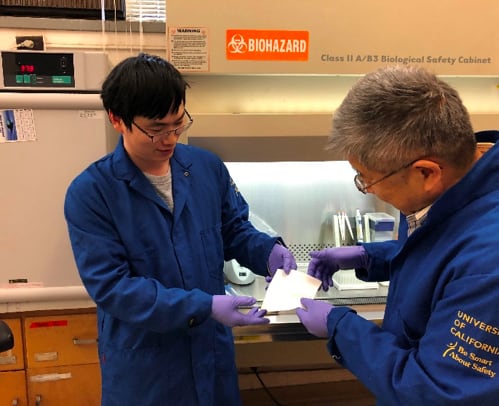
A new photo-active and rechargeable nanofibrous material that can efficiently destroy bacteria and viruses could one day be integrated into personal protective equipment (PPE) to prevent the outbreak of emerging infectious diseases. The material, which works by producing biocidal reactive oxygen species (ROS) in response to sunlight, is active even in dim or dark conditions, unlike previous such photo-antimicrobials that needed light irradiation to function.
Emerging infectious diseases (EIDs) are a serious global health problem. Such diseases include severe acute respiratory syndrome, bird flu and Ebola virus disease (EVD). The 2014 EVD outbreak in West Africa, for example, killed nearly 40% of the 28,646 infected civilians and more than 50% of the 852 diagnosed healthcare workers.
To prevent EID spread, healthcare workers are advised to wear PPE such as face masks, bioprotective suits and medical gloves. Although these minimize pathogen transmission, they do not completely eliminate the risk of catching an infection. Biocides, such as triclosan, nisaplin and solutions containing silver nanoparticles, can be used too, but they need to reapplied frequently.
ROS kill bacteria and inactivate viruses
A team led by Gang Sun of the University of California at Davis made its polymer-based nanofibrous membranes using an electrospinning technique. The membranes contain benzophenones and polyphenols, which are widely employed as photosensitizers in biochemistry and organic synthesis. These compounds rapidly generate ROS when exposed to sunlight in the presence of oxygen thanks to a photoreaction that involves hydrogen abstraction by the nanomembranes and subsequent oxidation.
“Once the pathogens have been intercepted and are in contact with the surface of the nanofibres, the photoactive biocides produce various ROS, including hydroxyl radicals, superoxide and hydrogen peroxide, explains team member Yang Si. “These ROS kill bacteria and inactivate viruses by damaging DNA, RNA, proteins and lipids.”
Rechargeable, so work even in dim or dark conditions
“The photoactive materials we used can store the biocidal activity under light irradiation thanks to their rechargeable function and readily release ROS even in dim or dark conditions,” he says. “In comparison, previous photo-antimicrobial materials could only work when irradiated with light and many of these even required high-energy UV light.”
The membranes quickly and effectively kill pathogenic bacteria and viruses when in contact with them. “For example, over 99% of bacteria (such as E. Coli and L. innocua) are killed in less than two hours and over 99% of viruses (such as T7 phage) in less than 30 minutes either under light exposure or dark conditions,” Si tells nanotechweb.org. “To compare, previous such membranes required 10 to 20 hours of contact with the bacteria or viruses.”
Towards commercialization?
The researchers have shown that the membranes can be used as a biocidal layer in many routinely employed PPE – for example 3M’s N100 respirator and DuPont’s Tyvek protective suit. In the respirator application, they can filter out and kill E. Coli, for example, in aerosol form. “They might also be used as a protective layer in face masks and medical gloves to defend again pathogens in either aerosol or liquid forms,” adds Si.
The team, reporting its work in Science Advances DOI: 10.1126/sciadv.aar5931, says that it is now busy developing PPE containing its nanofibrous materials. “We will try to produce these materials in large quantities and, in collaboration with industrial partners, integrate them into existing nonwoven production lines, which could allow us to commercialize the technology.”



